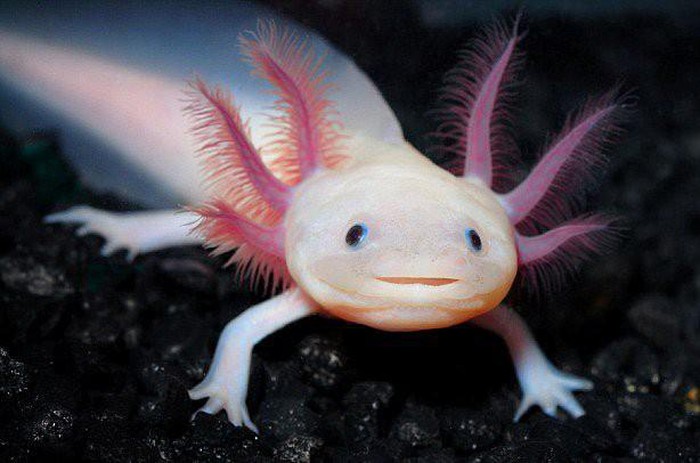Axolotl (Mexican iguana or six-horned dinosaur) is actually one of the most exotic and unique animals in the world. With tiny black eyes, a smiling mouth and a strange nose, Axolotl is different from most animals.
While captive Axolotl is often found in aquariums and laboratories, wild Axolotl is harder to find. This is because the only place they live is Xochimilco Lake in Mexico.
Axolotls are often eaten by locals of Xochimilco, who consider them a delicacy. They are deep fried along with cornstarch. However, Axolotl is threatened, the citizens of Xochimilco are forced to stop eating them. But some restaurants in Osaka, Japan still serve this dish to this day.

This is an extremely special feature, Axolotl never matures. Instead they always keep the look young, lovely. During the larval stage, they continue to grow and then at a certain point they will stop. For comparison, this would be like a tadpole keeping the tadpole in shape without developing into frogs.
Incredible reproducibility
Many amphibians can regenerate, but the ability to regenerate the body like Axolotl is not comparable. They can regenerate almost any part of the body, including the spinal cord, jaw and limbs. When a part is regenerated, it will leave no scars or any signs.
When attacked by predators, they are willing to sacrifice some parts to escape, new parts will grow very fast and Axolotl can regenerate hundreds of times. Each time, the new unit was still working perfectly.
"Treasure" of the laboratory
From a very early age, in 1863, the French moved to Paris 5 salamander to live for research.
Later, scientist Auguste Duméril bred this species successfully, bringing it across Europe. This is a respectable thing compared to the technology at the time, making salamander one of the first "residents" to grow in the laboratory.
After nearly 2 centuries, science has discovered many interesting things about salamander. For example, although they are amphibians, during the breeding season, the Mexican salamander does not land as its "cousin" but stays underwater. So science also calls them "adult tadpoles".
But, the most special is the ability to heal itself. When a Mexican salamander breaks off its limb, it will regrow, even repeatedly, but it will not affect life.
This regeneration is completely impossible in mammals, including humans. Because, if animals are injured, macrophages - a type of immune cell - will "eat" dead cells and leave scars.
The Mexican salamander is the opposite. When a limb breaks, a group of cells called blastema (multiple stem cells) will cover the wound, heal and regenerate. Thanks to the blastema cell group, the salamander can partially regenerate the damaged heart.
Legendary story about the god Xolotl
The ancient Aztecs believed that the six-horned dinosaur was the embodiment of the god Xolotl - a boatman carrying the dead to the afterlife. Xolotl had a dog's head and seemed afraid of being deported or killed, he escaped from everyone by turning into an Axolotl. This is also the reason the name Axolotl was born.






 Olm salamander, strange animals do not budge for 7 years, eat once every 10 years
Olm salamander, strange animals do not budge for 7 years, eat once every 10 years Scientists read the bird's brain and know what it is about to sing
Scientists read the bird's brain and know what it is about to sing Cuddling with cats can cause brain swelling, heart infection
Cuddling with cats can cause brain swelling, heart infection The rare giant 'living fossil' salamander stuck two years in the sewer line
The rare giant 'living fossil' salamander stuck two years in the sewer line Signs of heart disease should not be ignored
Signs of heart disease should not be ignored